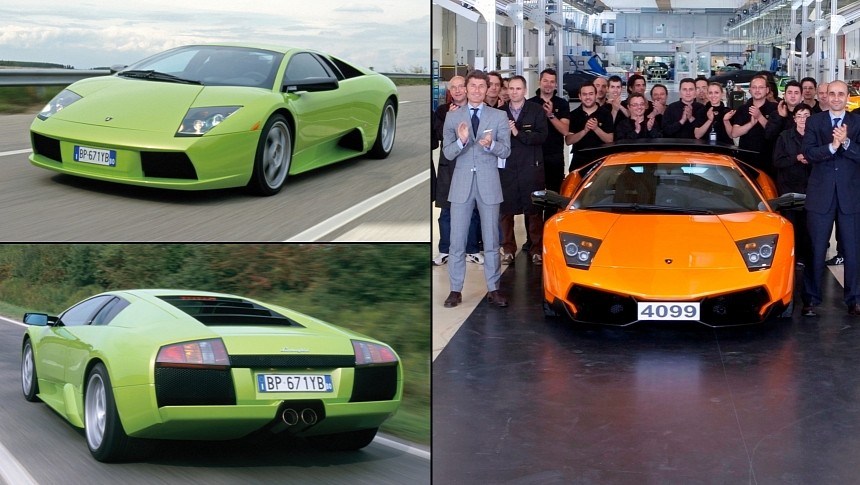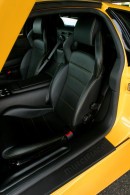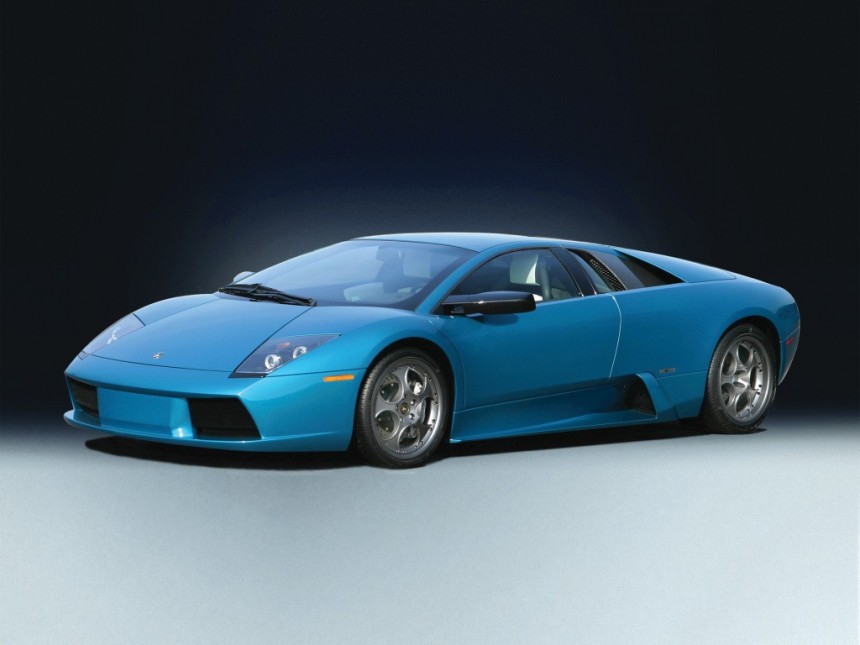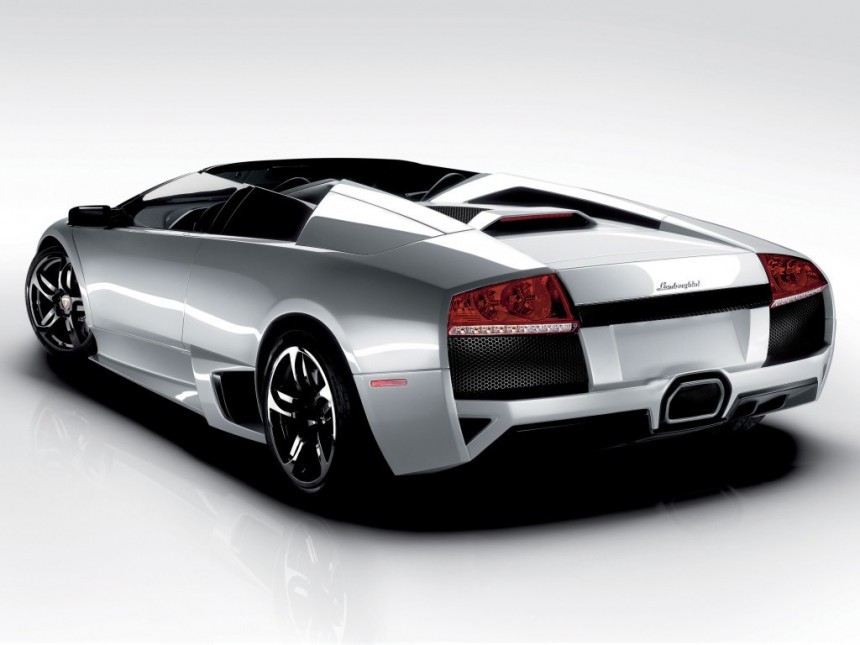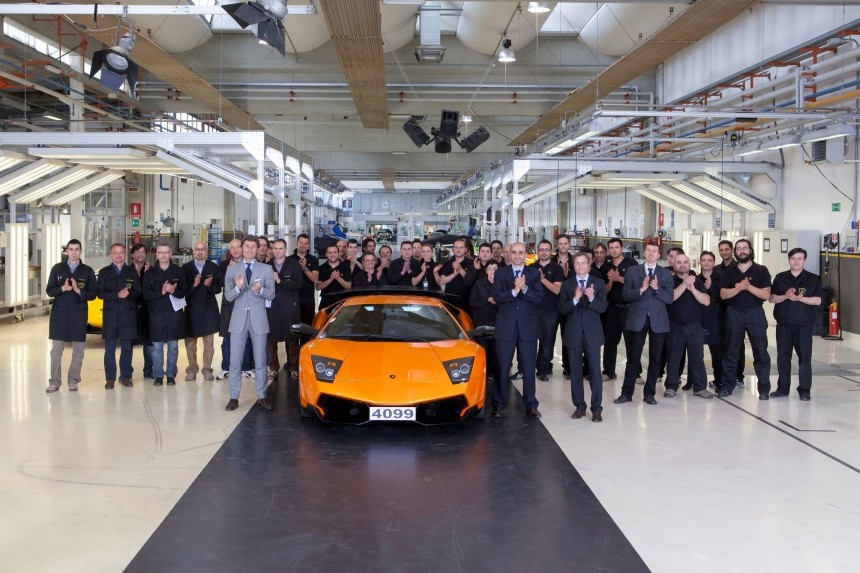Giotto Bizzarrini created Automobili Lamborghini's first-ever production engine, a naturally-aspirated V12 that was born out of spite for Enzo Ferrari. First and foremost, Ferruccio had a score to settle with Il Commendatore. But more importantly, Giotto was one of the leading Ferrari engineers who called it quits with the Prancing Horse as part of the Great Walkout.
Ferruccio and Giotto wanted to show Enzo that he was badly wrong for insulting both of them. Lamborghini's founder paid the Italian engineer a bonus for every metric pony over Ferrari's equivalent V12. From a displacement of 3.5 liters, the resulting engine would be adapted to 3.9, then 4.8, and so forth. Care to guess how this evolution came to a halt? Murcielago would be the answer, with Volkswagen-owned Lamborghini modifying said powerplant to 6.5 liters for the SuperVeloce.
Unveiled at Lamborghini's factory in September 2001, then revealed at the Frankfurt Motor Show, the Murcielago is a fabulous machine that blurs the line between old and new Lamborghini. It nearly didn't happen, though, because Lamborghini had already developed a replacement for the Diablo before the Volkswagen Group started calling the shots in Sant'Agata Bolognese. Internally referred to as L147, and better known as Canto, the stillborn replacement for the Diablo was axed from series production by Ferdinand Piech. You know: grandson of Ferdinand Porsche, big kahuna at Volkswagen, and driving force behind the Bugatti Veyron.
Piech did commission Volkswagen's design department, as well as outside design studios like Zagato, to come up with better styling for the Canto. All of them failed to deliver something worthy of a flagship, which is why the German automaker ultimately decided on a clean-sheet design for the Murcielago. Penned by Luc Donckerwolke and facelifted by Filippo Perini, the Murcielago wowed pretty much everyone upon its long-anticipated reveal. Wide, low, and gifted with a restrained aggressiveness to its exterior styling, the fourth-generation flagship is called this way after an especially valiant fighting bull. His life was spared by the matador in 1879, after which Murcielago was donated to a fighting bull breeder whose name may surprise you: Miura. Does it ring a bell?
The penultimate evolution of Bizzarrini's all-alloy V12 features a displacement of 6,192 cubic centimeters, resulting from an 87-millimeter bore (like the Diablo) and an 86.8-millimeter stroke. As expected of a midship supercar, Lamborghini went for a dry-sump lubrication system. Not only does it lower the center of gravity for better handling, but a dry-sump lubrication system is better for sustained cornering.
Boasting a compression ratio of 10.7:1 and a variable air-flow cooling system, this 6.2-liter masterpiece also rocks a variable-geometry intake, drive-by-wire throttle, and dual VVT. Similar to the succeeding Aventador and current-generation Revuelto, the Murcielago uses port fuel injection. The only transmission available in 2001 was a gated manual. Come September 2003, the E-Gear automated manual was introduced at the Frankfurt Motor Show. E-Gear models feature shift paddles and three shift modes: Low Adherence in case of bad weather, the self-explanatory Normal, and Sport.
Series production of the Murcielago kicked off in October 2001, with right-hand-drive models following suit in March 2022. Longer and wider than the Diablo, the Murci also happens to be taller. The first Raging Bull not designed by an Italian features aluminum doors and a steel roof. The rest of the bodywork is carbon fiber in order to keep the weight low.
Originally rated at 572 horsepower (580 ps) and 479 pound-feet (650 Nm) of torque, the V12-engined supercar is approximately 60 percent stiffer than its predecessor. The secret to said improvement is the tubular spaceframe with a carbon-fiber center section. Offered with all-wheel drive exclusively, the Murcielago splits torque 70 percent to the rear wheels and 30 percent to the front wheels by means of a viscous coupling. 15 millimeters longer than the Diablo in terms of wheelbase, the fourth-gen supercar also stops on a dime thanks to four-pot brake calipers and 355-mm discs.
Electronic brake force distribution has to be mentioned as well, plus Pirelli P Zero Rosso ZR18 tires measuring 8.5 and 13 inches in width. Anti-roll bars can be found at both ends. In regard to suspension componentry, make that double wishbones and electronically-controlled shocks for every corner. Equipped with Speedline wheels, the Murcielago guzzles dino juice from a 100-liter (26.4-gallon) fuel tank.
The scissor-doored supercar also sweetens the deal with electromechanically-controlled air intakes. These open or close automatically, and the rear spoiler can deploy as needed as well. Depending on the aperture of these components, the drag coefficient of the Murcielago varies between 0.33 and 0.36. Marketed as Murcielago rather than LP 580-4 after engine setup, metric ponies, and all-wheel drive system, the Murcielago tips the scales at 1,650 kilograms (3,638 pounds). 0.2 seconds quicker from naught to 100 kilometers per hour (62 miles per hour) than the Diablo 6.0 VT, the Murci is – at least officially – slower. Be that as it may, 330-plus kph (205-plus mph) is fast enough for public roads and the racetrack.
The LP 640 was introduced with the facelift, which is more than simply a restyled Murcielago. The brake rotors are larger, there's new software as well, and the engine was enlarged to 6.5 liters. The LP 640 has 304 more cubic centimeters to its name, thanks to 1 extra millimeter for the cylinder bores and 2.2 extra millimeters for the stroke.
Rated at 631 horsepower (640 ps) and 487 pound-feet (660 Nm), the 6.5-liter engine needs 3.4 seconds to reach 100 clicks. Top speed is officially rated at 340 kilometers per hour (211 miles per hour) for the coupe and 336 kilometers per hour (209 miles per hour) for the roadster. Speaking of which, the open-top body style gained a special edition – the LP 650-4 – in March 2009. Although it features the same torque as the LP 640, power went up by 10 ponies by means of recalibrated engine management software. Only 50 units were produced.
The magnum opus of the Murcielago line is, obviously enough, the LP 670-4 SuperVeloce. It came solely as a coupe, and it birthed a special edition of its own. The LP 670-4 SuperVeloce China Limited Edition is the culprit. 10 units were delivered, all of them finished in matte gray over a black interior. The automated manual was standard, but at no extra cost, prospective customers could specify the gated manual. Those manual-equipped cars go for big money at auction these days, partly because manual supercars are a rarity in this day and age. Gordon Murray's GMA, for example, keeps the three-pedal arrangement alive in the no-nonsense T.50 and lesser T.33.
Horst von Saurma of motoring publication Sport Auto needed 7:42 to lap the Nurburgring in a bone-stock Murcielago LP 670-4 SuperVeloce back in 2010. It's a similar time to rally legend Walter Rohrl in a 997-generation Porsche 911 GT3, and it's only 0.5 seconds off a C6-generation Corvette ZR1 with German racing driver Sascha Bert behind the steering wheel.
Faster than a Taycan Turbo on the Green Hell, the Murcielago's swan song develops 661 horsepower (670 ps) and the same kind of torque as the LP 640 mentioned earlier. However, torque peaks 500 revolutions per minute later than the LP 640, at 6,500 compared to 6,000 revolutions per minute. Lamborghini originally intended to make 350 examples of the SuperVeloce, yet only 186 examples were eventually built.
The factory in Sant'Agata Bolognese stopped making the Murci on November 5, 2010. The Aventador was unveiled a few months later, in March 2011, at the Geneva Motor Show. 4,099 units of the Murcielago were built, with the final example of the breed coming in the guise of an orange SV. By comparison, the Aventador ended production after 11,464 units, the final car being a Swiss-bound LP 780-4 Ultimae.
Unveiled at Lamborghini's factory in September 2001, then revealed at the Frankfurt Motor Show, the Murcielago is a fabulous machine that blurs the line between old and new Lamborghini. It nearly didn't happen, though, because Lamborghini had already developed a replacement for the Diablo before the Volkswagen Group started calling the shots in Sant'Agata Bolognese. Internally referred to as L147, and better known as Canto, the stillborn replacement for the Diablo was axed from series production by Ferdinand Piech. You know: grandson of Ferdinand Porsche, big kahuna at Volkswagen, and driving force behind the Bugatti Veyron.
Piech did commission Volkswagen's design department, as well as outside design studios like Zagato, to come up with better styling for the Canto. All of them failed to deliver something worthy of a flagship, which is why the German automaker ultimately decided on a clean-sheet design for the Murcielago. Penned by Luc Donckerwolke and facelifted by Filippo Perini, the Murcielago wowed pretty much everyone upon its long-anticipated reveal. Wide, low, and gifted with a restrained aggressiveness to its exterior styling, the fourth-generation flagship is called this way after an especially valiant fighting bull. His life was spared by the matador in 1879, after which Murcielago was donated to a fighting bull breeder whose name may surprise you: Miura. Does it ring a bell?
The penultimate evolution of Bizzarrini's all-alloy V12 features a displacement of 6,192 cubic centimeters, resulting from an 87-millimeter bore (like the Diablo) and an 86.8-millimeter stroke. As expected of a midship supercar, Lamborghini went for a dry-sump lubrication system. Not only does it lower the center of gravity for better handling, but a dry-sump lubrication system is better for sustained cornering.
Boasting a compression ratio of 10.7:1 and a variable air-flow cooling system, this 6.2-liter masterpiece also rocks a variable-geometry intake, drive-by-wire throttle, and dual VVT. Similar to the succeeding Aventador and current-generation Revuelto, the Murcielago uses port fuel injection. The only transmission available in 2001 was a gated manual. Come September 2003, the E-Gear automated manual was introduced at the Frankfurt Motor Show. E-Gear models feature shift paddles and three shift modes: Low Adherence in case of bad weather, the self-explanatory Normal, and Sport.
Series production of the Murcielago kicked off in October 2001, with right-hand-drive models following suit in March 2022. Longer and wider than the Diablo, the Murci also happens to be taller. The first Raging Bull not designed by an Italian features aluminum doors and a steel roof. The rest of the bodywork is carbon fiber in order to keep the weight low.
Originally rated at 572 horsepower (580 ps) and 479 pound-feet (650 Nm) of torque, the V12-engined supercar is approximately 60 percent stiffer than its predecessor. The secret to said improvement is the tubular spaceframe with a carbon-fiber center section. Offered with all-wheel drive exclusively, the Murcielago splits torque 70 percent to the rear wheels and 30 percent to the front wheels by means of a viscous coupling. 15 millimeters longer than the Diablo in terms of wheelbase, the fourth-gen supercar also stops on a dime thanks to four-pot brake calipers and 355-mm discs.
Electronic brake force distribution has to be mentioned as well, plus Pirelli P Zero Rosso ZR18 tires measuring 8.5 and 13 inches in width. Anti-roll bars can be found at both ends. In regard to suspension componentry, make that double wishbones and electronically-controlled shocks for every corner. Equipped with Speedline wheels, the Murcielago guzzles dino juice from a 100-liter (26.4-gallon) fuel tank.
The scissor-doored supercar also sweetens the deal with electromechanically-controlled air intakes. These open or close automatically, and the rear spoiler can deploy as needed as well. Depending on the aperture of these components, the drag coefficient of the Murcielago varies between 0.33 and 0.36. Marketed as Murcielago rather than LP 580-4 after engine setup, metric ponies, and all-wheel drive system, the Murcielago tips the scales at 1,650 kilograms (3,638 pounds). 0.2 seconds quicker from naught to 100 kilometers per hour (62 miles per hour) than the Diablo 6.0 VT, the Murci is – at least officially – slower. Be that as it may, 330-plus kph (205-plus mph) is fast enough for public roads and the racetrack.
The LP 640 was introduced with the facelift, which is more than simply a restyled Murcielago. The brake rotors are larger, there's new software as well, and the engine was enlarged to 6.5 liters. The LP 640 has 304 more cubic centimeters to its name, thanks to 1 extra millimeter for the cylinder bores and 2.2 extra millimeters for the stroke.
Rated at 631 horsepower (640 ps) and 487 pound-feet (660 Nm), the 6.5-liter engine needs 3.4 seconds to reach 100 clicks. Top speed is officially rated at 340 kilometers per hour (211 miles per hour) for the coupe and 336 kilometers per hour (209 miles per hour) for the roadster. Speaking of which, the open-top body style gained a special edition – the LP 650-4 – in March 2009. Although it features the same torque as the LP 640, power went up by 10 ponies by means of recalibrated engine management software. Only 50 units were produced.
The magnum opus of the Murcielago line is, obviously enough, the LP 670-4 SuperVeloce. It came solely as a coupe, and it birthed a special edition of its own. The LP 670-4 SuperVeloce China Limited Edition is the culprit. 10 units were delivered, all of them finished in matte gray over a black interior. The automated manual was standard, but at no extra cost, prospective customers could specify the gated manual. Those manual-equipped cars go for big money at auction these days, partly because manual supercars are a rarity in this day and age. Gordon Murray's GMA, for example, keeps the three-pedal arrangement alive in the no-nonsense T.50 and lesser T.33.
Horst von Saurma of motoring publication Sport Auto needed 7:42 to lap the Nurburgring in a bone-stock Murcielago LP 670-4 SuperVeloce back in 2010. It's a similar time to rally legend Walter Rohrl in a 997-generation Porsche 911 GT3, and it's only 0.5 seconds off a C6-generation Corvette ZR1 with German racing driver Sascha Bert behind the steering wheel.
Faster than a Taycan Turbo on the Green Hell, the Murcielago's swan song develops 661 horsepower (670 ps) and the same kind of torque as the LP 640 mentioned earlier. However, torque peaks 500 revolutions per minute later than the LP 640, at 6,500 compared to 6,000 revolutions per minute. Lamborghini originally intended to make 350 examples of the SuperVeloce, yet only 186 examples were eventually built.
The factory in Sant'Agata Bolognese stopped making the Murci on November 5, 2010. The Aventador was unveiled a few months later, in March 2011, at the Geneva Motor Show. 4,099 units of the Murcielago were built, with the final example of the breed coming in the guise of an orange SV. By comparison, the Aventador ended production after 11,464 units, the final car being a Swiss-bound LP 780-4 Ultimae.
